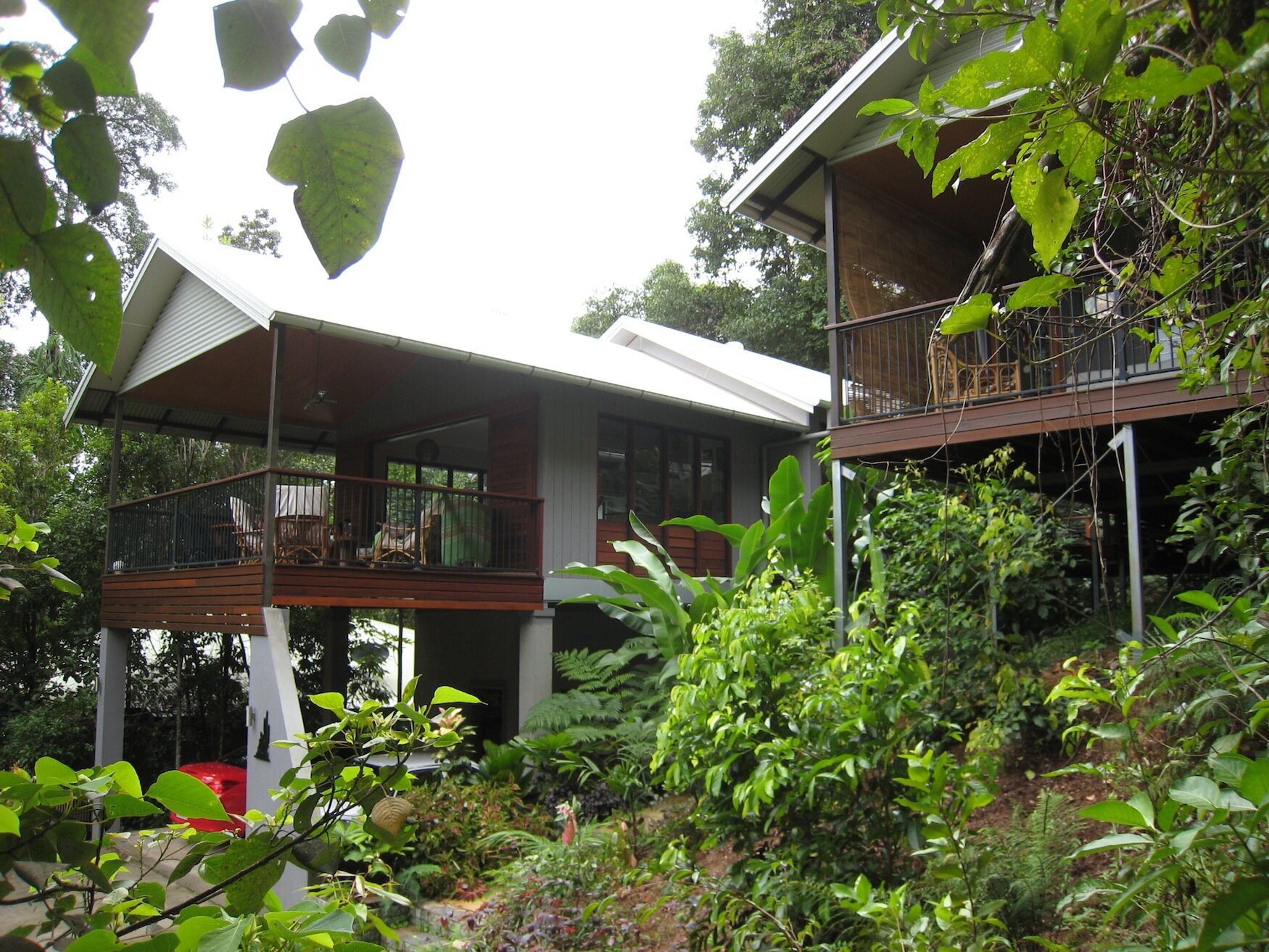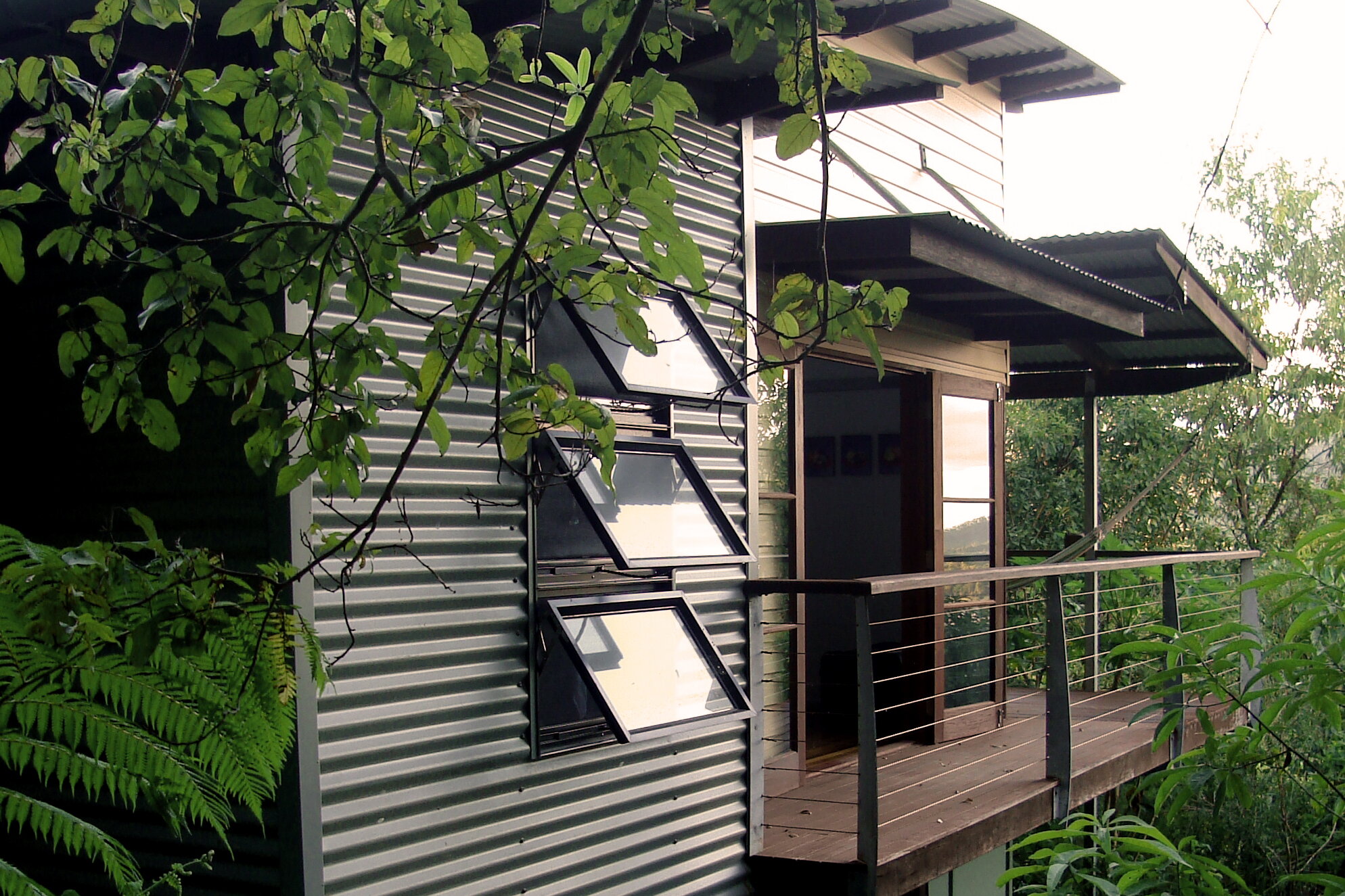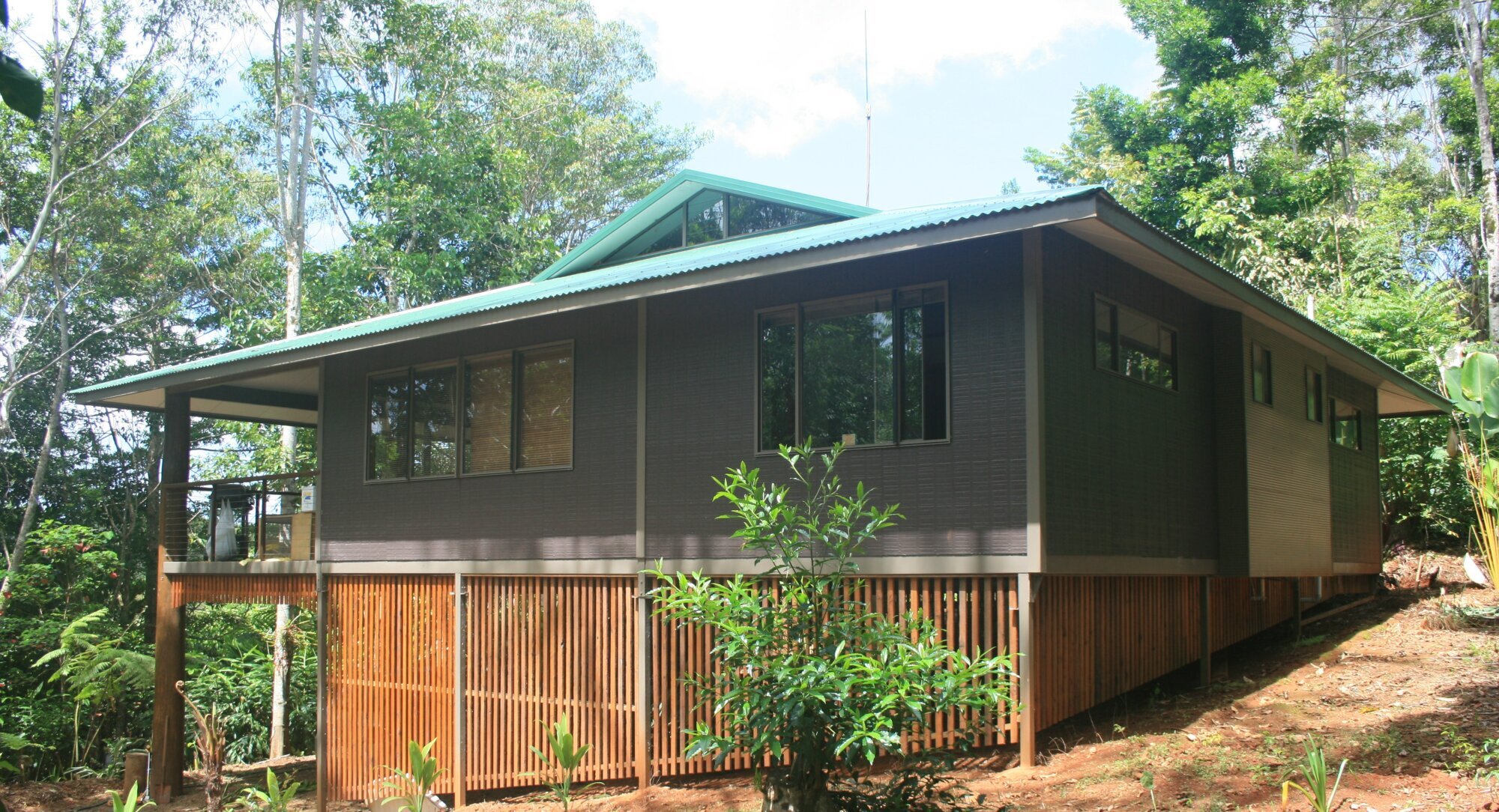Residential
Building Category: Residential
The Sunbird house was conceived as a demonstration project to break new ground and showcase expertise in tropical design and construction. It was built at a time when roof insulation was still an optional extra for many Cairns builders. Project highlights include the use of sustainable materials, energy saving technology, low emission living and passive design principles in tropical Queensland. The house was awarded a Master Builder's Association Energy Aware Home Award in 2002. It was open for inspection to the public for Sustainable House Day in 2008.
Building Category: Residential
This project was initiated in 1984 and completed in 1985. It was not originally conceived as an ecological or sustainable dwelling. However, the open design, the use of readily available materials on the property, and the topographical location resulted in the construction lending itself to be upgraded to an efficient sustainable and comfortable house design.
Building Category: Residential
Family activities are at the forefront for this young household, and are accommodated in a manner that allows parents to overview activities from any room in the house or central courtyard. Each room is connected by veranda space, which intertwines circulation, social and play areas.
Building Category: Residential
The home features a number of curved roof sections that fall strikingly well over vibrant walls of purple, wild moss and charcoal. The external face of the house hosts stunning banks of timber louvers and sweeping expanses of curved verandas on all sides. This home has been skilfully built with a focus on the tropics. Designed for a large extended family, this home is full of practical sustainable design features including recycled and plantation timbers.
Building Category: Residential
This is a modest tropical townhouse on a 195m² freehold block. It demonstrates exemplary infill development, both in its streetscape presentation and also as part of the broader development of the small inner urban subdivision.
Building Category: Residential
Located in the Wet Tropics of Far North Queensland the home adjoins World Heritage rainforest and State Forest and is in close proximity to the Barron River.
Building Category: Residential
The brief for this home was to create an affordable sustainable home for the project home market. Members of the Tropical Green Building Network in conjunction with a builder/project manager and building designer worked with local suppliers to showcase sustainable materials and create a home to educate the public on sustainable design and building. This home is a viable affordable building alternative with a total cost of $265,000 with no ongoing power bills.
Building Category: Residential
This is a new home that uses 100-year-old timbers salvaged from the demolition of the original Walsh River bridge. The bridge pylons were used as verandah posts and other timbers laminated and joined using ‘new aged' iron to create roof beams, trusses and fascias. It was awarded the 2011 Master Builders State Award for Excellence in Sustainable Living.
Building Category: Residential
The owners held a long term desire to build their own home and were at a stage of life where they had the skills, resources and the capacity to take time off work and funds to do the construction without raising a mortgage.
The basic objective was to build the home in an affordable manner, using recycled materials whenever possible and using methods with the least effect on surrounding vegetation and soil.
The basic objective was to build the home in an affordable manner, using recycled materials whenever possible and using methods with the least effect on surrounding vegetation and soil.
Building Category: Residential
The Eco-Savannah house design focuses on ways in which a typical suburban house can be used to facilitate practical family living with energy, water and resource efficiency in both construction and use. Incorporating passive solar design techniques suited to the tropics, the house makes the most of cool breezes, while keeping heat out and daylight in.
Building Category: Residential
The client was a licensed builder and HIA Greensmart professional wanting an affordable, practical and comfortable family home that applied green building principles. The Kula house typifies the traditional ‘longhouse’ design, a climate responsive building type common to the cultures of the Pacific islands and Southeast Asia. The house is named after ‘Kula’ shells that are valuable in the PNG Trobriand Islands. Trobrianders believe that mere argument is unlikely to change someone's mind and the art of persuasion through indirect and subtle means like the physical allure of gifts such as valuable ‘Kula’ shells are a vital part of negotiation. The ‘Kula’ barter system is an inherent part of this culture.
Building Category: Residential
The project encompasses four detached ‘units’ on a property in Cairns North. The site originally contained a Queenslander to the front of the site that had undergone a number of renovations, and a solid masonry shed to the rear of the site. Using old and new, each residence has its own identity and place, while the complete project is a successful tropical interpretation of the unit / townhouse typology.
Building Category: Residential
Set on a secluded and private lot on the flanks of Mt Whitfield in Cairns, this is the architect’s own home. The principle aims of this low budget project included simple, elegant and unpretentious form, easy access, minimum site impact, sustainability and low maintenance.
Building Category: Residential
The design for Kamerunga Rainforest House commenced using CAD software on a laptop computer while sitting on a log in the forest on site. The design was conceived as two narrow, elevated pavilions connected by a generous, central timber deck. The configuration provides deep shading from the sun and allows natural breezes to penetrate easily throughout the house. One pavilion contains all shared living areas, while the second pavilion contains all bedrooms and bathrooms. The house commands views westward to the nearby Kuranda mountain range while the eastern end of each pavilion provides views of the forest and seasonal creek below. Louvre windows are used extensively to maximize cross-ventilation, and the lightweight, elevated and well shaded construction retains no heat.
Building Category: Residential
Apex residence was conceived as the designer’s own residence. It is a place of retreat for a young working couple that blends the seemingly opposed paradigms of close connection to land and nature within a necessarily suburban location.
Building Category: Residential
The Oribin House case study consists of old and new parts. The original Oribin House was built in 1958 in Whitfield, Cairns and the new additions were completed in 2011. The original Oribin House is important in demonstrating the influence of international architectural trends on Australian architects in the mid-20th century, in particular the concept of organic architecture promoted by Frank Lloyd Wright, and was strongly influenced by Lloyd Wright’s (1867-1959) Usonian houses. The new building additions have considered the need to express the original building in its context, and are respectful of the value of the original design.
Building Category: Residential
A high energy-rated 3 bedroom dwelling that was quickly constructed to minimize disruption to guests staying at the Rose Gums Wilderness Retreat. Using Jon Nott’s newly patented wall fixing process FASTABUILD, the project was completed on-site in 3 weeks as the wall frames were assembled off-site the previous prior.
Building Category: Residential
Designing a house for ourselves seemed like it would be an easy task however our design brief ended up being more demanding than the average client. We had a block with water views from the front. We wanted to be slightly elevated to capture the views and be cool during summer. We wanted an open plan design and we did not want any air-conditioning.
Building Category: Residential
This elevated three storey home combines sustainability with elegance and luxury. Constructed from recycled materials and plantation timber, passive building design principles have been enhanced by Gateway Constructions' patented breathable wall system. Ventilated roofing, window and door positioning for cross ventilation and site orientation all maximise energy efficiency.
Building Category: Residential
The client approached the architect with a design for a small studio dwelling to be constructed on their acreage property bordering the Clohesy River on the edge of Barron Gorge national park. The property had no mains power or water, but had an existing shed (which the clients were living in) and solar power system.
Building Category: Residential
This project is a re-presentation of Phillip Johnson’s Glass House in New Canaan, Connecticut, USA – less the glass – making it a perfectly adaptable modernist prototype for contemporary living in tropical latitudes. This residence is a new housing prototype and a re-think of the possibilities of a typical suburban context within our tropical cities.
Building Category: Residential
The clients are a retired couple with a 6.1 hectare property adjacent to the Daintree National Park in North Queensland. They required a residence that could be rented out as an executive holiday home during the peak tourist season and used as their residence for the rest of the year.
Building Category: Residential
The client brief required the delivery of a comfortable holiday house in the tropics.
Building Category: Residential
‘Alkira’ the Stamp House is particular to our client, a stamp dealer among other things including property developer, who had purchased 26 hectares of beach front land in the Daintree. The clients had a strong desire to develop a sustainable and robust estate which would ideally operate as carbon neutral in its off-grid location. They had concerns regarding the annual cyclone season and associated events such as storm surge associated with king tides. They also wanted to enhance the site’s natural wetland environment.
Building Category: Residential
This was a difficult sloping site adjoining the rainforest that encouraged a ‘tread lightly on the earth principal’ (careful site works protect the environment and often costs less). Designing with light weight construction and a minimal flat platform ensured interaction with this spectacular rainforest site at all times.




_main_web900.jpg)
.JPG)


.JPG)












GlassHouse_PatrickBinghamHall.jpg)


.jpg)


